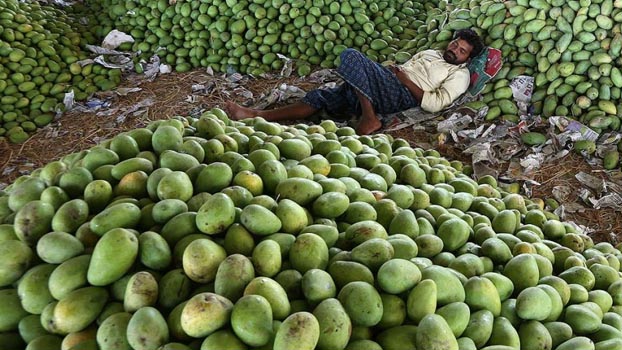Lockdown impact on growers
Mango farmers, traders fearing huge loss

Mango growers and traders, especially in the northern region, may suffer huge losses in this season due to the nationwide lockdown amid the novel coronavirus crisis.
While mangoes, the most juicy and delicious fruit of the summer season, are scheduled to start appearing in the local markets in the Rajshahi, Chapainawabganj and other districts by the end of this month, the growers and traders have failed to prepare themselves as yet with the lockdown continuing.
The main growers, traders and a large number of workers related to the trading in the Rajshahi and Chapainawabganj districts while expressing grave concern said they apprehend an acute crisis in the coming days as the lockdown has cast a shadow on production and marketing of the product that provides their livelihood.
“We know nothing about our future. We did never see such a situation in the past. Our trading usually starts gaining momentum in different markets of Rajshahi and Chapainawabganj districts with the appearing of varieties of the seasonal fruits along with the rush of buyers from across the country at this time. But our growers have not gone for harvesting as yet. As a result are also failing to start trading,” president of Mango Traders Association, Khademul Islam told journalists.
Meanwhile, a mango orchard owner Abdul Majid said that there are almost 500 mango growers in the region on whom at least 5000 seasonal workers depend for their livelihood.
The wholesale markets famous for mango trading like Baneswar, Shaheb Bazar, Haragram, Upashahar, Shalbagan, Rajabari, Godagari, Kansat and Rohanpur would normally get an eye-catching look.
Growers and traders would make the wholesale markets pulsate in a festive mood.
Besides, many of the small-businessmen would also be seen selling mangoes on roadsides or vending in localities on rickshaw-vans and other modes of carriers.
But this time the shutdown has cast a cloud of gloom clouds over the markets which in the past years remained crowded round the clock.
Besides the markets, haats and other growth centre ones, the mango-based trade and business over the years changed the rural economic scenario of the region as a whole.
As possibilities of mango export increased from last year, mango farmers in Capainawabganj started to grow mangoes maintaining international standards. However, now they are fearing losses of Tk 1500 this season.
It is to be noted, the country has the capability to produce 1.0 million tonnes of mangoes a year. A popular mango was awarded the GI (Geographical Indication) tag from the World Intellectual Property Organisation last year. The mango is Khirshapati, popularly known as Himsagar.
Meanwhile the fruit setting stage is progressing well and the mango trees have started wearing eye-catching looks in the orchards, gardens and homestead areas in Rajshahi and Chapainawabganj districts.
Mango, a leading seasonal cash crop of the northwestern region, dominates the economy of these districts.
Dr Alim Uddin, Principal Scientific Officer of Fruit Research Station (FRS) said that 95 percent mango trees have bloomed abundantly during this season on an average, and the fruit setting stage is progressing well.
Shamsul Haque, Deputy Director of the Department of Agriculture Extension (DAE), said, there are around 35 lakh mango trees of different ages and varieties on some 32,816 hectares in the region with the creation of many mango orchards and increased mango farming in the homesteads in recent years years.
In Rangpur, mango farmers are expected to bring around 7,500 hectares of land under mango cultivation during this season in all five districts of its agriculture region.
Mango farmers are mostly cultivating popular varieties of mango like ‘Haribhanga’, ‘Mohanbhog’, ‘Gopalbhog’, ‘Lengra’, ‘Fazlee’, ‘Khirsapati’, ‘Chyatapori’, ‘Lakhna’, ‘Amrapali’ and ‘Nakfazlee’ in these region.




